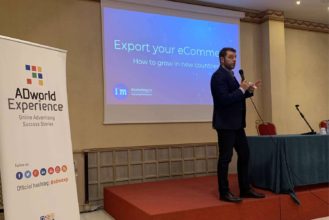how U.S. e-commerce companies can succeed in Europe. Trends. Tools. Opportunities.
On 10.07.2020 we have organized a webinar entitled “How U.S. e-commerce companies can succeed in Europe. Trends. Tools. Opportunities.”. During the webinar, you met Sergej Volvenkin (PhD) who is Senior Export Strategic Planner at iMarktings.eu. and Jakub Mazal who is a Strategic Planner at Google.
Let’s look in detail what we talked about during our event.
European Data
In this video series we discuss how U.S. e-commerce companies can succeed in Europe. Trends. Tools. Opportunities.
This short video is about general eCommerce data in Europe.
591 billion U.S dollars comes from ecommerce sales in Europe making this a very attractive market for overseas ecommerce companies. This is compared with 749 billion U.S. Dollars from North American eCommerce sales.
In Europe there are 646 million internet users which makes this market very attractive for eCommerce companies. Europe is a big and growing market however, you need to take into account that it is fragmented.
There are 44 countries in Europe speaking 200 languages though only 24 of these are official languages, English the most popular. Many countries mean many cultures with the Internet penetration rate varying by region for example, Western Europe is 82% more developed compared to 62% of Central and Eastern Europe.
Smartphone penetration is at a very high level and you should take this into account when building your market entrance strategy.
As Europe is made up of many countries you can’t enter into the European market in one go, you have to enter in to each country separately. Digital buyer penetration data can help you to gain more insight into which country could be the most attractive for your business but you have to remember, in the countries with more customers who are open to buying your product, there could be much higher competition.
Free shipping is still the most important feature for European digital buyers. The second is a reliable website.
UK data
In this video series we continue to discuss how U.S. e-commerce companies can succeed in Europe. Trends. Tools. Opportunities.
This short video is about general eCommerce data in Europe’s largest eCommerce country, the United Kingdom.
With 135 billion U.S. Dollars, the United Kingdom (UK) is the biggest ecommerce market in Europe and the trend is growing.
9 out of 10 users in the UK buy products online. But don’t think this is an easy market to enter, competition is very high as is the cost of advertisement.
For UK consumers, the 3 most important factors which help them to make a purchase decision when shopping online are as follows:
- Good value for money
- Free Shipping
- Product Information
Black Friday is very popular in many European countries and the UK is no exception. If you’re going to export to the UK, be ready for Black Friday and Christmas / Christmas Sales.
German data
In this video series we continue to discuss how U.S. e-commerce companies can succeed in Europe. Trends. Tools. Opportunities.
This short video is about general eCommerce data in Europe’s second largest eCommerce country – Germany
With 79 billion U.S. dollars in eCommerce sales Germany is the second largest eCommerce market in Europe and the trend is growing.
84% of users in Germany are shopping online.
For German shoppers, the 3 most important factors which help them to make purchase decision when shopping online are:
- Returns Policy
- Free Shipping
- Product Variety
3 Important Steps. Step 1: Plan & Research
In this video series we continue to discuss how U.S. e-commerce companies can succeed in Europe. Trends. Tools. Opportunities.
This video is about the 3 important steps which are a must if you wish to get sustainable growth in Europe.
Europe is fragmented so you need to think on a country level rather than classing Europe as a single market to conquer.
Keep watching to see examples from particular countries and discover how iMarketings.eu helps eCommerce companies grow in Europe. We will use the 3 step plan based on one of our client examples in Czech Republic and Sweden.
The 3 steps we follow to start promotion in the European markets are:
- Plan & Research
- Prepare
- Promote & Scale
Let’s look closer at each of them…
According to Google research, the top obstacle companies face in the very beginning is “Lack of market insights”.
Some tools to help companies research the market are:
- Google Keyword Planner
- Google Trends
- Google Market Explorer
- Semrush
- Similarweb
- eMarketer
When entering into the European market, most U.S businesses automatically think of selling on Amazon but, although Amazon is the top eCommerce platform in 4 of Europe’s top eCommerce countries; the UK, Germany, France, and Italy, it is not the best place to start selling in every European country.
Google Market Explorer can show your product category interest, interest growth and entrance cost (from Google Search perspective). You can also use the query share to find out which language users are searching in on Google.
Similarweb gives traffic source insights which gives you the opportunity to define strategic channels by category (though not always).
Google Keyword Planner is a free tool which gives you the opportunity to define search volumes and calculate clicks, budget, and transaction forecasts.
In some countries Google is not the only search engine that should be taken into consideration. In the Czech Republic the Seznam search engine has a strong market position and as the second most popular web resource in the country, can bring up to 25% of revenue.
Price comparison portals play an important role in almost all European countries too and can bring up to 20% of revenue.
Companies should find out the conditions for each price comparison portal and prepare all data (feed etc.) before investing money in paid ads.
You will need to analyse and audit your competitors’ website, this includes product page, check out, delivery options, payment methods, return policy, competitive advantages, prices, customer support etc.
3 Important Steps. Step 2.1: Prepare Local Content
In this presentation we continue to discuss how U.S. e-commerce companies can succeed in Europe. Trends. Tools. Opportunities.
This short presentation is about content localization which is a preparation activity from step 2. To recap, there are 3 must follow steps if you wish to get sustainable growth in Europe. Step 1 is Plan & Research, Step 2 is Prepare, and step 3 is Promote & Scale.
According to Harvard Business Review, 72% of consumers spend most of their time browsing websites in their own language. We can see that website language is important in other Google research which shows that 56% of Europeans are not open to using websites which are not written in their own language.
Other Google research reveals that 82% of shoppers are more likely to buy if the website is in their own language.
It’s important to remember that translation is not the same as localization so companies should always localize content rather than just translate it.
3 Important Steps. Step 2.2: Prepare Delivery Options
In this presentation we continue to discuss how U.S. e-commerce companies can succeed in Europe. Trends. Tools. Opportunities.
This short presentation is about delivery options which is a preparation activity from step 2. To recap, there are 3 must follow steps if you wish to get sustainable growth in Europe. Step 1 is Plan & Research, Step 2 is Prepare, and step 3 is Promote & Scale.
According to a PostNord report, 61% of customers will choose a different online merchant if they offer delivery options which are more suitable to their needs.
In many European countries, users prefer home delivery. According to eMarketer, in Spain 27% of customers prefer their purchase to be delivered to the post office and the same share of users prefer to have their order delivered to work. 64% of online buyers in France prefer delivery to a parcel shop.
Most shoppers prefer a delivery time of 3 to 5 days with people in the UK and Poland likely to pay extra for next day delivery.
You should provide all of the most popular delivery methods for each particular country.
3 Important Steps. Step 2.3: Prepare Payment Methods
In this presentation we continue to discuss how U.S. e-commerce companies can succeed in Europe. Trends. Tools. Opportunities.
This short presentation is about payment methods which is a preparation activity from step 2. To recap, there are 3 steps to follow if you seek sustainable growth in Europe. Step 1 is Plan & Research, Step 2 is Prepare, and Step 3 is Promote & Scale.
According to Google research, 67% of Europeans will abandon their online shopping cart if the website does not support local payment options.
You should ensure your website accepts the most popular payment options in each particular country – PayPal and Debit/Credit card are the most preferred payment options in most European countries.
3 Important Steps. Step 2.4: Prepare Customer Service
In this presentation we continue to discuss how U.S. e-commerce companies can succeed in Europe. Trends. Tools. Opportunities.
This short presentation is about customer service which is a preparation activity from step 2. To recap, there are 3 steps you should follow if you wish to get sustainable growth in Europe. Step 1 is Plan & Research, Step 2 is Prepare, and Step 3 is Promote & Scale.
According to Microsoft research, 64% of consumers have stopped doing business with a company due to a poor customer service experience. Users have different response time expectations across different channels but according to a PostNord report, most users expect free and fast support.
3 Important Steps. Step 2.5: Prepare GDPR
In this presentation we continue to discuss how U.S. e-commerce companies can succeed in Europe. Trends. Tools. Opportunities.
This presentation video is about GDPR which is a preparation activity from our 2nd step for achieving sustainable growth in Europe in which we have Step 1: Plan & Research. Step 2: Prepare. Step 3: Promote and Scale.
GDPR stands for General Data Protection Regulation. It is a strict law that, though passed by the European Union, imposes obligations onto organizations anywhere in the world if they target or collect data from people in the EU. It’s a law that protects user’s personal data and privacy, letting individuals know how a company is going to use their data (the company website must inform them) and if user doesn’t agree, gives them a chance to unsubscribe from every email, remarketing list and so on whilst also giving them the option to request access to all personal data that the company holds on them.
If European companies, as well as those dealing with the transfer of EU users’ data outside of the EU and EEA areas, don’t follow GPPR a fine up to 4% of the company’s turnover is imposed by the government.
3 Important Steps. Step 3: Promote & Scale
In this presentation we continue to discuss how U.S. e-commerce companies can succeed in Europe. Trends. Tools. Opportunities.
This presentation is about entrance strategies in the European market which is an activity from our 3rd and final step for getting sustainable growth in Europe. As a reminder, Step 1 was Plan & Research and Step 2 was Prepare.
There are many market entrance strategies to choose from. We’ll describe two of them here.
Model 1 focuses on fast expansion, growth and market share but doesn’t take into account ROI. Model 2 has the opposite focus with ROI the most important factor and Target KPI in a short period of time (3-6 months).
Model 2 is less risky and allows for market testing before the company makes a greater investment. The test period depends on the country, market, and situation but is usually 3-4 months. In this short period of time it’s important to use channels which allow the company to target “hot” and “warm” leads aka users (allowing them to take the low hanging fruit). If in these initial 3-4 months performance is positive, the company can scale marketing activities and ensure faster growth while still keeping Target ROI in mind.
If performance is low during the first 3-4 months, the company can pause to find and fix problems before increasing their budget further.
It’s important to remember that creatives and brand ideas are as important as use of the digital marketing channel so please, take care with the creative before entering into the European market.


